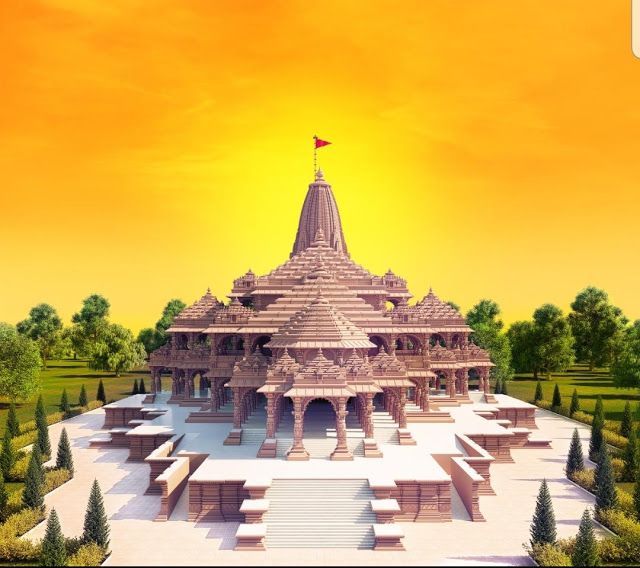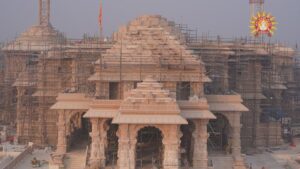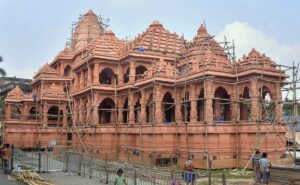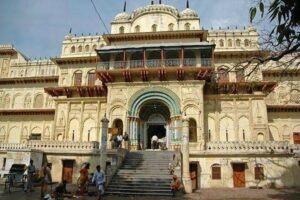Ram Mandir Ayodhya

Introduction
In the sacred city of Ayodhya, the majestic Ram Mandir stands as a beacon of spirituality, culture, and history. More than just an architectural wonder, it embodies the devotion and aspirations of millions. The temple’s grand construction represents the resurgence of India’s deep-rooted heritage, blending intricate craftsmanship with timeless tradition.
Every pillar and carving reflects the epic tale of Lord Ram, reinforcing the spiritual connection between past and present. The temple’s completion marks a momentous chapter in India’s journey, celebrating religious harmony and cultural unity. Pilgrims from across the world visit Ayodhya to witness this divine marvel, experiencing a profound sense of peace and devotion.
Ram Mandir is not just a structure; it is a testament to India’s unwavering faith, resilience, and the spirit of righteousness. As it stands tall in Ayodhya, it continues to inspire generations, rekindling the essence of dharma and devotion in every heart.
Ram Mandir Ayodhya Historical Context
Ram Mandir Ayodhya: The Holy Land
Located on the banks of the Sarayu River, Ayodhya is a city resonating with spirituality and history. It is considered the birthplace of Lord Rama, a revered figure in Hinduism and the protagonist of the epic Ramayana. The city has a century of religious significance. The construction of Ram Mandir is the culmination of long-standing aspirations for the temple at the birthplace of Lord Rama.
Babri Masjid controversy:
The history of Ram Mandir is linked to socio-political issues. These have been ongoing for decades, particularly concerning the Babri Masjid controversy. A dispute arose over the Babri Masjid. Some say it was built on the ruins of the 16th-century temple, believed to be the birthplace of Lord Rama. After years of legal battles and public unrest, India’s Supreme Court cleared the way for the construction of the Ram Mandir. The historic ruling came in 2019 on the disputed site.
An architectural marvel
Design philosophy:
The architecture of Ram Mandir is a harmonious blend of traditional and modern elements. Decorated with sculptures depicting scenes from the Ramayana. The temple is a visual spectacle that transports visitors to a time of eternal beauty. The design philosophy reflects not only the aesthetic sensibility of the architects but also the spiritual ethos within the place.
Shikhara and Mandapa: Ram Mandir Ayodhya 
The towering Shikara of Ram Mandir stretches into the sky, symbolizing divine presence. Embossed with motifs narrating Lord Rama’s legend, the Shikara serves as a devotional lamp. A mandapa, or prayer hall, is a large space where the congregation gathers to pray and soak in the divine aura. Architectural elements are seamlessly combined to create a space that resonates with serenity and piety.
Cultural influence
A pilgrimage:
The completion of Ram Mandir made Ayodhya a famous religious pilgrimage site. Devotees from all over the country and beyond flock to this holy place to seek blessings and connect with their spiritual roots. The pilgrimage to Ayodhya became a symbolic journey for millions, reinforcing the importance of faith in the formation of cultural identity.
A symbol of unity:
The construction of Ram Mandir was a catalyst to promote unity and understanding among different communities. An inclusive approach to design and construction reflects a desire to bridge and transcend religious divides. The temple is not only a place of worship for Hindus, but also a symbol of India’s commitment to pluralism and social harmony.
The socio-political landscape

The political significance of Ram Mandir Ayodhya :
The Ram Mandir is of great political importance, with its construction influencing the political landscape of the country. From the beginning of the Babri Masjid controversy, the journey has witnessed various political and ideological events leading to the construction of the temple. The completion of the temple has, in many ways, shaped the discourse on cultural nationalism. It has also influenced the role of religious identity in Indian politics.
Legal odyssey:
The legal battle over the Ayodhya case is an important case that is testing the strength of the Indian judiciary. The Supreme Court’s 2019 decision set a precedent for resolving controversial issues through legal means, creating a sense of convergence in a decades-long legal battle. The legal journey around the Ram Mandir highlights the importance of a reliable and impartial judiciary in upholding the principles of justice.
Economic consequences of Ram Mandir Ayodhya
Tourism and infrastructure
The completion of Ram Mandir has given a significant boost to tourism in Ayodhya. The inclusion of pilgrims and tourists has led to the development of infrastructure such as hotels, restaurants and transportation facilities. The economic benefits extend far beyond the church, creating job opportunities and contributing to the economic development of the entire region.
Professional empowerment
The construction of Ram Mandir provided employment opportunities for artisans and skilled craftsmen. The intricate patterns and sculptures that adorn the temple are the result of the hard work and experience of these artists.
Historical Context

Ram Mandir Ayodhya: The Holy Land
Located on the banks of the Sarayu River, Ayodhya is a city steeped in spirituality and history. It is considered the birthplace of Lord Rama, a revered figure in Hinduism and the protagonist of the epic Ramayana. The city has been a sacred pilgrimage destination for centuries. The construction of Ram Mandir is the realization of a long-cherished aspiration to build a grand temple at Lord Rama’s birthplace.
Babri Masjid Controversy
The history of Ram Mandir is intertwined with socio-political struggles that lasted for decades. The Babri Masjid controversy revolved around claims that the 16th-century mosque was built on the ruins of a Hindu temple, believed to be the birthplace of Lord Rama. After years of legal battles and public unrest, the Supreme Court of India delivered a historic verdict in 2019, allowing the construction of the Ram Mandir at the disputed site.
An Architectural Marvel
Design Philosophy
The architecture of Ram Mandir seamlessly blends traditional and modern elements. Every inch of the temple is decorated with sculptures and carvings depicting scenes from the Ramayana, creating an aesthetic and spiritual experience. The temple serves as a visual masterpiece, transporting visitors to an era of devotion and divine beauty.
Shikhara and Mandapa
The Shikhara (tower) of Ram Mandir rises high into the sky, symbolizing divine connection. Embossed with sacred motifs and scriptures, the Shikhara embodies the grandeur of Lord Rama’s legend. The Mandapa (prayer hall) is a vast spiritual sanctuary where thousands of devotees gather for prayers and meditation, experiencing serenity and divine blessings.
Cultural Influence

A Pilgrimage Destination
With the Ram Mandir now complete, Ayodhya has emerged as a major spiritual hub. Devotees from across the country and the world visit the temple, seeking blessings and inner peace. The pilgrimage to Ayodhya has now become a profound spiritual journey, deepening the faith and cultural identity of millions.
A Symbol of Unity
The Ram Mandir represents more than religious significance—it stands as a symbol of national unity. The temple’s construction has fostered communal harmony and an inclusive approach, reinforcing India’s commitment to pluralism and social togetherness.
The Socio-Political Landscape
The Political Significance of Ram Mandir
The Ram Mandir has been at the center of India’s socio-political landscape for decades, influencing ideological debates, electoral politics, and national identity. Its journey from a legal dispute to a unified religious symbol has left an enduring impact on India’s political and cultural narrative.
1. Ram Mandir and Cultural Nationalism
- The temple’s construction is often seen as a symbol of India’s cultural resurgence.
- It has strengthened Hindu identity, reinforcing the significance of faith in national discourse.
- Political parties have utilized the Ram Mandir movement to mobilize public sentiment, making it a focal point in Indian politics.
2. Electoral Politics and Ram Mandir
- The issue of Ram Janmabhoomi has been a key electoral agenda for political parties, influencing voter behavior.
- Several political movements, from the 1980s Vishwa Hindu Parishad (VHP) campaign to recent elections, have used the temple as a symbol of unity and revival.
- Leaders and parties have positioned the temple’s construction as a promise of cultural restoration and governance based on traditional values.
3. Role of Judiciary and Legal Milestones
- The Ayodhya land dispute case was one of India’s most significant legal battles, spanning over a century.
- The Supreme Court’s 2019 verdict in favor of the Ram Mandir was seen as a historic moment that upheld constitutional justice while respecting religious sentiments.
- The case set a precedent for resolving sensitive religious and historical disputes through legal channels, rather than political unrest.
4. Influence on India’s Social Fabric
- The construction of Ram Mandir has influenced interfaith relations, fostering dialogues on religious coexistence.
- While the movement has had moments of social tension, the temple today stands as a symbol of reconciliation and national pride.
- The government’s role in ensuring a harmonious transition from dispute to construction showcases India’s commitment to secularism and faith-based harmony.
5. International Perspective
- The Ram Mandir movement has gained global attention, shaping India’s cultural diplomacy.
- Leaders and Hindu communities worldwide have celebrated the temple’s completion, reinforcing India’s soft power and global religious heritage.
- The temple has positioned Ayodhya as a global spiritual center, attracting interest from scholars, religious leaders, and tourists.
Legal Odyssey
The Ayodhya land dispute was one of the most complex legal battles in India’s history. The Supreme Court’s 2019 verdict was a landmark decision, showcasing the judiciary’s role in resolving deep-rooted conflicts through legal means. The case underscored the importance of law, justice, and national unity.
Economic Impact of Ram Mandir

Tourism and Infrastructure Development
The completion of the Ram Mandir has significantly boosted tourism in Ayodhya. The influx of pilgrims and tourists has led to rapid infrastructure development, including hotels, restaurants, and improved transportation facilities. The economic growth extends beyond religious tourism, benefiting businesses and local communities.
Employment and Skill Development
The construction of Ram Mandir has generated employment opportunities for artisans, laborers, and craftsmen. The intricate carvings and temple sculptures highlight India’s rich artistic traditions, ensuring the preservation of age-old craftsmanship. This has led to skill empowerment and a revival of traditional arts.
Spiritual Significance of Ram Mandir
The Ram Mandir is not just a place of worship but a sacred symbol of devotion. It represents Lord Rama’s ideals—truth, righteousness, and dharma. Devotees believe that visiting the temple brings spiritual peace and blessings. The temple is an epicenter of faith, where pilgrims gather to chant hymns, participate in religious rituals, and immerse themselves in divine energy.
Mythological Importance of Ayodhya
According to the Ramayana, Ayodhya was the capital of the Ikshvaku dynasty, ruled by Lord Dasharatha, father of Lord Rama. It is described as a golden city filled with prosperity and devotion. The presence of the Ram Mandir reinforces this mythological connection, making Ayodhya a sacred and timeless land for Hindus.
Festivals and Celebrations at Ram Mandir
- Ram Navami – The grandest celebration, marking the birth of Lord Rama with elaborate rituals and processions.
- Diwali in Ayodhya – Celebrates Lord Rama’s return to Ayodhya after 14 years of exile. The city is decorated with millions of diyas (lamps).
- Deepotsav – A spectacular festival where the temple and city are illuminated with lights, attracting pilgrims and tourists worldwide.
These events have turned Ayodhya into a cultural and religious epicenter.
Art and Craftsmanship of Ram Mandir
The intricate carvings and sculptures of the temple are masterpieces of Indian craftsmanship.
- Traditional Nagar-style architecture showcases fine stone carvings.
- Exquisite murals and pillars depict scenes from the Ramayana.
- Artisans from all over India contributed their skills, reviving ancient temple-building techniques.
The temple is a living testament to India’s rich artistic heritage.
Impact of Ram Mandir on Ayodhya’s Development
The construction of Ram Mandir has led to a transformation of Ayodhya:
- Modern infrastructure – Improved roads, railway stations, and an international airport.
- Boost in local businesses – Handicrafts, tourism, and hospitality industries have flourished.
- Employment growth – Thousands of jobs created in construction, tourism, and services.
The temple has reshaped Ayodhya into a global spiritual destination.
Conclusion
The Ram Mandir in Ayodhya is more than just a temple; it is a symbol of faith, unity, and India’s cultural resurgence. Its construction marks the fulfillment of a centuries-old aspiration, reflecting the unwavering devotion of millions. Rising majestically on the holy land of Lord Rama’s birthplace, the temple stands as a testament to resilience, righteousness, and spiritual harmony.
Beyond its religious and historical significance, the Ram Mandir has contributed to economic growth, cultural revival, and national unity. It has transformed Ayodhya into a global pilgrimage hub, fostering both spiritual enrichment and developmental progress.
As this architectural marvel continues to inspire devotees and visitors, it reinforces the essence of dharma, tradition, and harmony. The Ram Mandir’s legacy will be cherished for generations to come, serving as a beacon of faith and cultural pride in India’s ever-evolving journey.
Read More Info
Click To Read More:- History Of Ram Mandir


